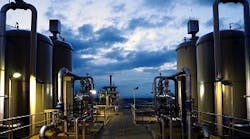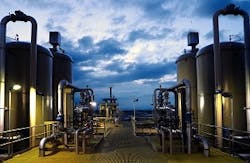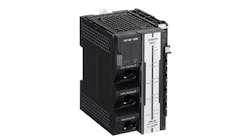Software, edge devices and MQTT-based networking simplify H2S process
Figure 1: Reduction-oxidation (redox) units built by Streamline Innovations remove toxic, explosive hydrogen sulfide (H2S) from upstream natural gas by employing reusable reduction-oxidation chemistry, updated surfactants, filters and other processes. They're monitored and coordinated by automated and model-based controls, which are enabled by Ignition software and Python scripts that perform regression analyses, and let the semi-autonomously units run independently or be controlled remotely via smart phones. Source: Streamline Innovations
Process automation mostly makes operations perform better, but sometimes it makes them possible in the first place. While many potential applications are technically feasible, operational difficulties and process variability render them unaffordable, so they're never implemented or scaled up—at least not until technical innovations come along that makes them economically viable and profitable.
For instance, toxic, explosive hydrogen sulfide (H2S) gas is found in 30-40% of upstream natural gas wells, while oxidation-reduction (redox) chemistry to convert it into fertilizer-grade sulfur has been available for 50-60 years. However, prior efforts to commercialize this process were only marginally successful due to persistent operational challenges, and because variations in operating conditions made the process costly, according to Peter Photos, Ph.D, executive VP for engineering and chief scientist at Streamline Innovations in San Antonio, Texas.
The company designs, builds, leases, integrates and operates large, manned and small,semi-autonomous H2S-to-sulfur units into correspondingly sized natural gas wells and processing facilities. Streamline also employs its Valkyrie process with updated chemistry, modern surfactants, and automation and controls. Its small units are about the size of a large truck, and can process 200-5,000 pounds of sulfur per day, treating an average of 3-7 million standard cubic feet of natural gas, while its large units are as big as half a football field, and can produce 20,000-34,000 pounds of sulfur per day. It also builds autonomous, micro devices that perform ancillary tasks in remote locations.
Streamline presently operates one large gas treatment facility, has run three semi-autonomous units for the past 18 months, and added four more in the past few weeks. This gives it a total of five mid-sized units in south Texas and two in west Texas, where it plans to add three more small and one large plant soon.
Redox tricky to outfox
Photos reports redox requires running two precise chemical reactions, but they're hard to maintain. "We have an advisor, who worked on some old redox plants in the 1980s. In those days, he could manage to make that process work efficiently when he was onsite, but as soon as he left, it became inefficient because there were so many variables to tweak and maintain," says Photos. "Turning H2S into sulfur—and doing so without destroying the chemistry—requires keeping all of the chemistry in equilibrium, so it's crucial to keep all the process variables within a narrow range to ensure the unit operates economically. It's especially hard when the input variables, flow rate and H2S concentration can vary from minute to minute.”
Redox processes in the past never gained full adoption, according to Photos. Instead, a chemical called triazine was used, but it's also expensive, and can only be used once, in a one-way reaction that doesn't allow any chemical recycling. The attractiveness of redox is its chemical destroys H2S to make sulfur, but later air can be added to the spent chemicals, rejuvenating them for reuse.
"Because we're both reducing and re-oxidizing our chemistry, redox is much less costly. This is why the process was tried from the 1950s through the 1990s, but the problem was the two chemical processes, reduction and oxidation, could not be optimally controlled" explains Photos. "This is also tricky because H2S concentrations in natural gas vary, as well as flow rates, so the corresponding amount of chemistry added to the gas needs to be constantly adjusted. If too much chemistry is added, it can't be regenerated. However, if too little is added, then some H2S might get into the pipeline. Likewise, we pump in air to regenerate our chemicals, but if too much air goes in, this process won't work either. This is why the old process required an advisor in the field to check concentrations and flow rates every few minutes."
Unfortunately, experts can't be onsite at all times in all natural gas facilities, or even travel to them frequently, especially to smaller units on remote wells. The Valkyrie process replaces the "advisor in the field" with controls, allowing the process to maintain that equilibrium without human intervention. This allows Streamline's H2S-to-sulfur process to succeed and scale up.
Photos reports Streamline first tried an automation platform written on a standard PLC, but it couldn't perform the complex calculations and model-based controls required by its semi-autonomous operations, or allow remote and bidirectional control of the units and equipment as needed. Likewise, while the plant-sized units are large and complex enough to merit 24/7 manned operations, they still need real-time process analytics, onsite HMI access by operators, and remote data access by in-office engineers. Meanwhile, its small units require basic, low-cost automation with remote data access and local HMI access without any added equipment or resources that could make tradition PLC-based automation too costly.
Automation extends chemistry
Photos explains that Streamline's improved redox chemistry, called Talon, grew out of U.S. and European restrictions on phosphates in detergents that took effect in the late 1990s.
"New chemicals had to be developed for dishwashing detergents, and these were in the same class as those needed for redox, so we selected the one that was the most suitable," says Photos. "We also add surfactants that improve what used to be a very goopy and messy process. However, we still needed to automate our human pieces, such as manual checks on reactions, sampling and in-house lab analyses, and making adjustments accordingly. We selected an array of sensors and probes that measure continuous pH, salt concentration and some other parameters, and programmed soft sensors to intelligently calculate others. From there, models and scripts perform calculations and make projections based on data. For example, the PC performs linear regression analyses to determine iron concentration (for which no probe exists), which in turn lets the predictive model make real-time adjustments to the chemistry circulation rate."
To solve its redox challenges, reduce variability and stabilize its process, Photos adds that Streamline sought more capable monitoring, interfaces and controls for its semi-autonomous units. Each unit includes:
- 400 tags on the redox unit and equipment;
- One Rockwell Automation PLC, one Moxa Edge PC and one ProSoft wireless gateway;
- A cloud computer with historian and mobile connectivity, with further connection to a master PostgresSQL open-source relational database management system; and
- 1,800 data points per project, logged each second for most values.
For its smaller units, Streamline uses Inductive Automation's Ignition SCADA software in a hub-and-spoke configuration with its stripped-down Ignition Edge version running on a Moxa device that communicates with an Ignition server via MQTT communication protocol. MQTT allows transfers of relevant data without consuming much bandwidth, which means cellular data in remote areas are usually sufficient for operations. Streamline also developed a web-based mobile app that lets users access data from their unit, including all historian data, and perform full, bidirectional control for any authenticated user.
"Raw production data goes to the unit's ControlLogix PLC, and is then sent to Ignition Edge, which conducts further calculations such as matrix algebra, fuzzy logic and regression analyses," says Photos. "Further, larger, calculations are done by the cloud server, and other data such as weather forecasts come in through third-party APIs. Results are delivered back to the PLC, which adjusts its PID loops and other devices. The PLC treats these results like data from a sensor, and performs its own adjustment calculations, which makes it easy to measure and correct flows."
[javascriptSnippet]
On its larger redox units, Streamline has extended Ignition by running a full version with its Perspective module deployed via a local Wi-Fi network. This allows users to access historian data onsite, and lets them eliminate dedicated HMIs because any PC or tablet can wirelessly access Perspective and serve as an interface. The company is also connecting its unit networks and servers to its overall cloud-computing service, so data can be integrated in one repository. Streamline is also working on eliminating PLCs entirely in its smaller units by running Ignition Edge on a Moxa device to manage I/O points and data, supplemental Python code to do calculations, and MQTT to relay data back to the cloud.
Saved by software scripts
Running in parallel to the Ignition software are several Python software scripts that enable Streamline's complex calculations, including fast-Fourier transforms on pump vibration and weather forecasts from the U.S. National Weather Service to help determine optimal operating temperatures, which wouldn't be possible with a PLC alone. This system also relays auto-notifications and alerts when issues arise to operators and management via the Twilio cloud communications platform.
"We use PLCs for controlling the redox units at a minute-to-minute level, but adding Ignition software and Python scripts helped tasks like our iron concentration testing because PLCs can't do the linear regressions and linear algebra calculations needed, but Python easily can, as well as allowing bidirectional control via Ignition," adds Photos. "This is important because mechanical items can go wrong, need maintenance, or experience other events. In the small units, the sulfur dumpster usually needs to be emptied once a week, while the filter paper runs out and needs to be changed every two weeks. This is where auto-alerts generated by Ignition and delivered by Twilio in texts to operators can save a lot of time."
Similarly, the mobile app works with Ignition Vision and Ignition Perspective apps to let users manage the Valkyrie units from their smartphones. "For example, if a unit loses power and shuts down, operators can safely restart it remotely, as well as change set-points and swap probes with their phones. If a unit is behaving weirdly or has a bad algorithm, they can use their phones to switch algorithms," explains Photos. "They only have to go to a site if there's a mechanical issue, which means a two-person team can provide 24/7 coverage to about 10 semi-autonomous sites. And, instead of having to visit the site, engineers can sit in an office in San Antonio and make adjustments to even the large unit just as if they were there, which can mean huge savings. Finally, small and/or isolated units that used to get no coverage can now get their tanks and pumps monitored and adjusted regularly."
Present and future success
Beyond enabling its H2S-to-sulfur units, Streamline reports its Valkyrie process with Ignition-based automation, MQTT communication, Moxa computing and tiered intelligence has achieved a variety of data collection, process and remote control, and other performance gains and benefits. These include:
- 99.7% uptime for small units due to remote start, stop, restart, monitoring and auto-notification via SMS;
- One-second resolution for data acquisition that's allowed Streamline to develop better models to further improve unit accuracy and performance, and reduce chemistry costs by 35%;
- Machine-learning (ML) and fuzzy logic algorithms running on Python on top of Ignition to provide advanced control efficiency and a self-tuning system that increases operational efficiency even more;
- Better than 99% uptime on the large units, aided by custom HMI screens for local operations at specific locations and detailed control during maintenance;
- Much faster functionality checks during commissioning because system integrators could access the HMI at the instrument or on their tablets via WiFi; and
- Intelligent control deployed on the smaller units, allowing operators to visit sites biweekly instead of continuously.
"Machine learning is letting us build more predictive models for parameters like temperature and gas pressure, which helps us determine the best chemistry circulation and air flow rates to use," adds Photos. "Ignition gives us the flexibility to integrate weather forecasts for ambient temperatures and humidity, which can have a big impact sulfur production, and adjust our surfactant and pH levels for more optimal performance. Little things like humidity can affect the amount of water in our process, and there are many variables like this that we couldn't address before, but now we can because ML can be added to model-predictive control (MPC) with help from Ignition and Python scripts. We used to model units to within 20%, but now we can do it within 5% with MPC and Ignition by predicting operating conditions and the extent of our reduction and oxidation reactions. This is how automated, continuous control can make a process application economically viable."







